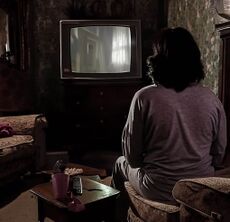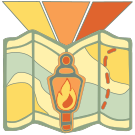Guide: Rooms and Boundaries
 | |
| Guide: Rooms and Boundaries | |
|---|---|
| Landmarks | Experiment with Mindfulness and Television |
Guides are a Pathway in The Map of Everyday Enlightenment which are typically articles about a particular time and place for meditative practices. Guides contain Landmarks that highlight examples of how this could work for you, as well as other explanations of how to make use of certain concepts or techniques. The Landmarks in Guides can be reviewed in the context of progress through the Realms of Everyday Enlightenment, and when used in that way, Guides become another way to decide where to go next.
The Guide to Rooms and Boundaries provides explanations, examples, and Landmarks about a shift in our conscious state whenever we move between rooms or look out a window. Beyond those simple examples, this Guide explores a number of similar perception shifts we can observe, especially is it relates to both Attention and Adaptation.
| This page is under construction Additional content and cleanup needed. |
How do Rooms and Boundaries fit in with the goals of Everyday Enlightenment?
The majority of these types of exercises are about being present in The Now. It may be that we are hard-wired to find comfort in just one "room" at a time, and experimenting with the feeling of awareness of other rooms and how they relate to each other is analogous to the feeling of being lost in thought and then being brought back to the present moment. To bring that point home, note two important goals of these exercises.
- Being aware of the quality of mind associated with the room you are in is something to develop, as it trains you to become present continually, and especially whenever you move between rooms, or notice a boundary between rooms.
- There is a strong parallel between what you experience with Rooms and Boundaries exercises and what you experience when shifting from being lost in thought and back to a clear and mindful mental state. Try to notice this parallel and appreciate its importance.
How to approach each of these exercises?
- Sense how your perception of "here" can rely heavily on what Room you are in. There is a clear sense that other Rooms are not this Room. Feel that difference, and move your perception between
- This Room
- That Room
- What contains both rooms
- Are there other rooms related? What about windows, mirrors, etc?
- Remember to pay attention to the change in mental clarity when you return your attention back to the room you're in.
Rooms
- Take a moment to feel the space of the room you are in, to the furthest corner, stopping that awareness at the ceiling, walls, and floors. Notice the difference in quality between rooms of different sizes and shapes.
- You can especially learn to do this whenever you cross through a doorway - encourage an immediate awareness of the boundaries of the new room you are in.
Doors and Windows
- In a room with many openings, notice the difference in quality between open doors (including doorways without doors), closed doors, and windows (including any transparent door)
- Appreciate how a window divides the space between the room you are in, and the space beyond, while at the same time inviting you to sense that the "outside" and the inside of the window are being brought together by the window because it is transparent. Be aware of the space of the room you are in, and the space of the "outside" and the space of the two places added together.
- Many of the Mirror exercises can be repurposed for Windows as well.
Fences and Walls
Even without actual walls and windows, we can still appreciate the quality of areas that are being divided. Some examples of how these exercises can apply everyday in many situations...
- In the neighborhood, there's a quality to be found when inside a backyard fence, or looking at another neighbor's yard in their fence, or passing by houses that have fences and knowing you are outside of those areas
- Inside a stadium there's a powerful feeling of thousands of people all being enclosed together within the boundaries of the stadium, whether it's indoors or outdoors
- Any kind of delineation such as a soccer field, even without fences, has a boundary
Mirrors
These exercises can be done whenever you are doing a stationary routine activity like brushing your teeth. Place a sticker on the mirror you use, near where your face is reflected, as this will be a visual cue you use when seeing the mirror as a special type of doorway. Take time to visually appreciate the following and notice the quality of your mind and awareness.
- Your body exists on "your side" of the mirror
- There are two bodies here, you can see them both at the same time
- The "mirror you" is more clear and real than the "real you" (See People.)
- The "mirror you" exists in a room with its own quality and feel, while being essentially the same room
- The mirror itself exists, independent of either room. Appreciate the quality of the mirror itself, while being fully aware of both selves.
- Relax your perception of the room being divided into two rooms, and feel it as one larger room, double the size. Move your perception back and forth between one room and two rooms.
Mouthwash in the Mirror
While using mouthwash (the kind that stings when you have it in your mouth long enough)...
- Watch yourself in the mirror
- Go back and forth between yourself, the surface of the mirror, the Self in the mirror, the Self behind the eyes and the Self that encompasses all this experience
- After becoming comfortable with these different states..
- Continue using your mouthwash, sensing it's affect on your mouth and all its parts
- Shift to the Self in the mirror and practice projecting the sensations onto that Self and at that moment feel that is certainly not you
- Repeat as many of these steps to appreciate what you are experiencing
Use the following Landmarks as ways to integrate meditative practices into your everyday life and to check in on how you are progressing in your own journey.
Landmark: Experiment with Mindfulness and Television
 | |
| Landmark: Experiment with Mindfulness and Television | |
|---|---|
| Beacons | Attention |
| Realms | Engagement |
| Lenses | Mindfulness |
| Guides | Rooms and Boundaries Television |
The Landmark of Experiment with Mindfulness and Television invites you to experience Mindfulness in another way to discover that Experience the Now is more complicated than just recognizing sights and sounds, it also means paying attention to your own mind, and in this case particularly how your own mind is perceiving and reacting to The Now. This Landmark is within the Realm of Engagement, and is part of the Beacon of Attention, more specifically the Lens of Mindfulness.
Landmark Lookouts:
- Mindfulness Near a Television: Can you be fully present and Mindful with a television playing in the room, which includes being mindful of the sound and light coming from the television?
- Mindfulness in the Television: Are you able to shift your mindfulness to the situations on the television as if you were in that scenario?
- Mindfulness of the Room and the Television: Are you able to extend your mindfulness to include both the scenario of the room you are in, and the scenario on the television, as if they were all taking place in the same Now?
With those questions in mind, try these steps while sitting at the TV.
- Enter a mindful state, and acknowledge that the television is a source of light, motion and sound in the room you are in. Mindfully notice the shape of your own room, what objects are in the room giving off sound and light or moving. For example, an overhead fan is providing a breeze, a gentle sound, and constant motion. Notice that the television is merely another object in the room, with no more significance than things like a fan or a lamp.
- Now shift your perspective into the television. Notice that you can be mindful of what is going on inside the television (the show, the movie, whatever it is) as if that was the whole world. Be fully present as if your universe was contained in the same universe as what is on TV. Your physical body, and the room around you melt into the background, and now you can engage in basic mindful activities from the perspective of a fly on the wall within the TV.
- What are the various background sounds? (Birds, cars, people talking softly at a table.) - Try some of the Sounds Skills.
- Whatever mindfulness exercises you personally connect with, try to apply them to what is on the television.
- If what you are watching doesn't lend itself to any of these exercises, that's okay. Instead, practice mindfully watching the show, without distraction, allowing the world around you to melt away, and drawing all your attention to what is on TV.
- Once more shift your perception, now to include both the world of the television, and your own world, as if the space and experience within the TV was taking place within the room you are in. This will not make contextual sense in many cases, but in some cases (for example) it would be easy to see the people on the TV sitting at a table and feel that they are sitting at a table in the room with you.
- Note that this exercise is very similar to how you might play with your perception in a Mirror. Try adapting some of those exercises to the television.
